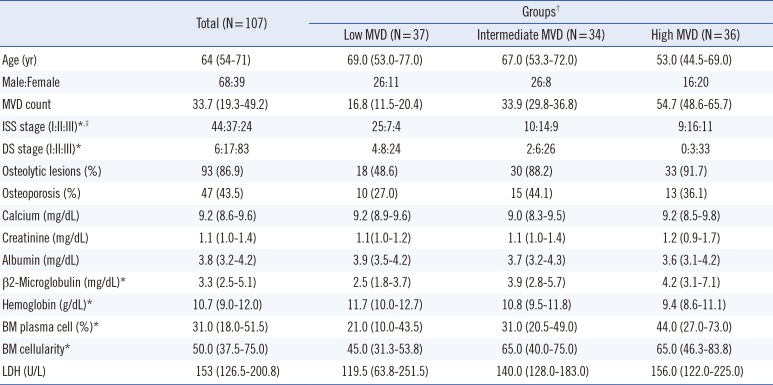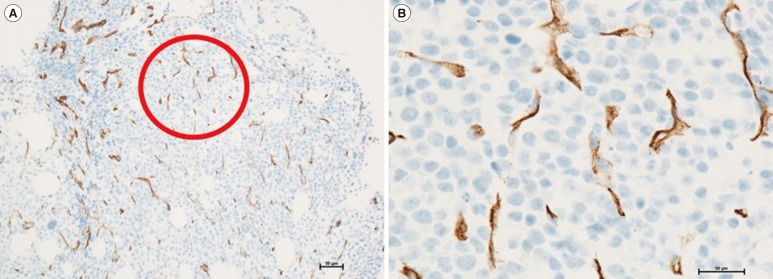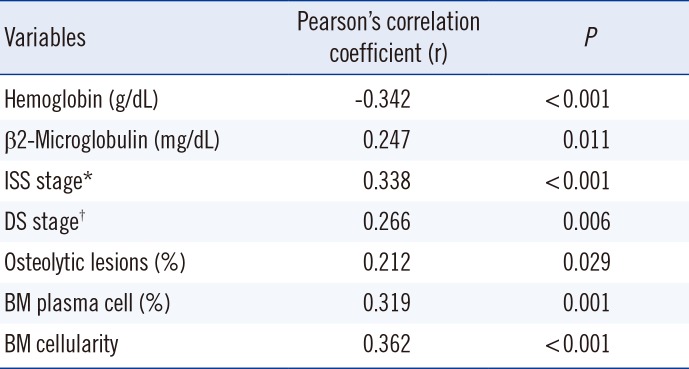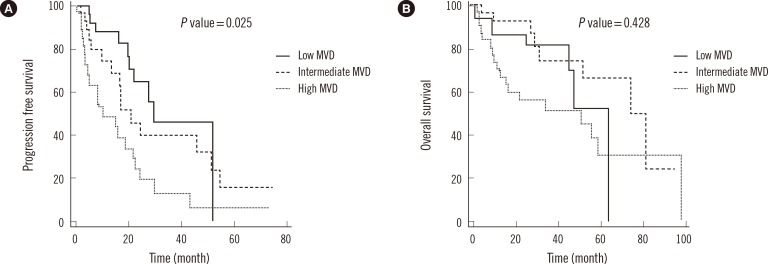1. Bergers G, Benjamin LE. Tumorigenesis and the angiogenic switch. Nat Rev Cancer. 2003; 3:401–410. PMID:
12778130.

2. Hong L, Han Y, Brain L. The role of epidermal growth factor receptor in prognosis and treatment of gastric cancer. Expert Rev Gastroenterol Hepatol. 2014; 8:111–117. PMID:
24410474.

3. Jakob C, Sterz J, Zavrski I, Heider U, Kleeberg L, Fleissner C, et al. Angiogenesis in multiple myeloma. Eur J Cancer. 2006; 42:1581–1590. PMID:
16797965.

4. Fan F, Schimming A, Jaeger D, Podar K. Targeting the tumor microenvironment: focus on angiogenesis. J Oncol. 2012; 2012:281261. PMID:
21876693.

5. Liu Y, Zhu XJ, Zeng C, Wu PH, Wang HX, Chen ZC, et al. Microvesicles secreted from human multiple myeloma cells promote angiogenesis. Acta Pharmacol Sin. 2014; 35:230–238. PMID:
24374814.

6. Vacca A, Ribatti D. Bone marrow angiogenesis in multiple myeloma. Leukemia. 2006; 20:193–199. PMID:
16357836.

7. Niemöller K, Jakob C, Heider U, Zavrski I, Eucker J, Kaufmann O, et al. Bone marrow angiogenesis and its correlation with other disease characteristics in multiple myeloma in stage I versus stage II-III. J Cancer Res Clin Oncol. 2003; 129:234–238. PMID:
12700896.

8. Oh HS, Choi JH, Park CK, Jung CW, Lee SI, Park Q, et al. Comparison of microvessel density before and after peripheral blood stem cell transplantation in multiple myeloma patients and its clinical implications: multicenter trial. Int J Hematol. 2002; 76:465–470. PMID:
12512842.

9. Pruneri G, Ponzoni M, Ferreri AJ, Decarli N, Tresoldi M, Raggi F, et al. Microvessel density, a surrogate marker of angiogenesis, is significantly related to survival in multiple myeloma patients. Br J Haematol. 2002; 118:817–820. PMID:
12181051.

10. Sezer O, Niemoller K, Eucker J, Jakob C, Kaufmann O, Zavrski I, et al. Bone marrow microvessel density is a prognostic factor for survival in patients with multiple myeloma. Ann Hematol. 2000; 79:574–577. PMID:
11100749.

11. Rajkumar SV, Leong T, Roche PC, Fonseca R, Dispenzieri A, Lacy MQ, et al. Prognostic value of bone marrow angiogenesis in multiple myeloma. Clin Cancer Res. 2000; 6:3111–3116. PMID:
10955791.
12. Kyle RA, Rajkumar SV. Criteria for diagnosis, staging, risk stratification and response assessment of multiple myeloma. Leukemia. 2009; 23:3–9. PMID:
18971951.

13. Anderson KC, Kyle RA, Rajkumar SV, Stewart AK, Weber D, Richardson P, et al. Clinically relevant end points and new drug approvals for myeloma. Leukemia. 2008; 22:231–239. PMID:
17972944.

14. Bhatti SS, Kumar L, Dinda AK, Dawar R. Prognostic value of bone marrow angiogenesis in multiple myeloma: use of light microscopy as well as computerized image analyzer in the assessment of microvessel density and total vascular area in multiple myeloma and its correlation with various clinical, histological, and laboratory parameters. Am J Hematol. 2006; 81:649–656. PMID:
16845660.

15. Cohen J. Statistical power analysis for the behavioral sciences. 2nd ed. Hillsdale, NJ: Lawrence Erlbaum Associates;1988.
16. Fonseca R, Bergsagel PL, Drach J, Shaughnessy J, Gutierrez N, Stewart AK, et al. International Myeloma Working Group molecular classification of multiple myeloma: spotlight review. Leukemia. 2009; 23:2210–2221. PMID:
19798094.

17. Kumar S, Gertz MA, Dispenzieri A, Lacy MQ, Wellik LA, Fonseca R, et al. Prognostic value of bone marrow angiogenesis in patients with multiple myeloma undergoing high-dose therapy. Bone Marrow Transplant. 2004; 34:235–239. PMID:
15170170.

18. Ahn MJ, Park CK, Choi JH, Lee WM, Lee YY, Choi IY, et al. Clinical significance of microvessel density in multiple myeloma patients. J Korean Med Sci. 2001; 16:45–50. PMID:
11289400.

19. Choi JH, Ahn MJ, Jang SJ, Park CK, Park YW, Oh HS, et al. Absence of clinical prognostic value of vascular endothelial growth factor and microvessel density in multiple myeloma. Int J Hematol. 2002; 76:460–464. PMID:
12512841.

20. Giuliani N, Storti P, Bolzoni M, Palma BD, Bonomini S. Angiogenesis and multiple myeloma. Cancer Microenviron. 2011; 4:325–337. PMID:
21735169.

21. Munshi NC, Anderson KC, Bergsagel PL, Shaughnessy J, Palumbo A, Durie B, et al. Consensus recommendations for risk stratification in multiple myeloma: report of the International Myeloma Workshop Consensus Panel 2. Blood. 2011; 117:4696–4700. PMID:
21292777.

22. Rana C, Sharma S, Agrawal V, Singh U. Bone marrow angiogenesis in multiple myeloma and its correlation with clinicopathological factors. Ann Hematol. 2010; 89:789–794. PMID:
20177896.

23. Sprindzuk M, Dmitruk A, Kovalev V, Bogush A, Tuzikov A, Liakhovski V, et al. Computer-aided Image Processing of Angiogenic Histological. J Clin Med Res. 2009; 1:249–261. PMID:
22481986.
24. Babarović E, Valković T, Štifter S, Budisavljević I, Seili-Bekafigo I, Duletić-Naćinovic A, et al. Assessment of bone marrow fibrosis and angiogenesis in monitoring patients with multiple myeloma. Am J Clin Pathol. 2012; 137:870–878. PMID:
22586045.











 PDF
PDF ePub
ePub Citation
Citation Print
Print


 XML Download
XML Download